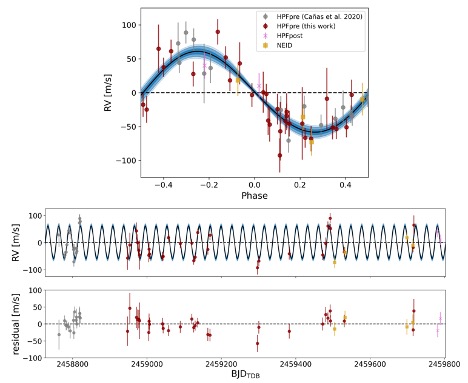
- About WIYN
- Observing at WIYN
Available Instruments
Optical Imaging
Infrared Imaging
Spectroscopy
Observing Tools
Observing Planning
At the Telescope
After Your Run
- Internal Use
WIYN Oversight
Calendars
The WIYN Observatory supports the current and future research and education needs of its scientists by operating and maintaining the WIYN facilities at a superb level of performance, and by developing opportunities to enable frontier astrophysical research.

Welcome Princeton University! Princeton has joined the WIYN Consortium as an operational partner. Read the full press release from Princeton.

NEID and HPF examine a rare ‘warm Jupiter’ around an M-dwarf and find it to be the coolest known example of such objects.
“The unusual M-dwarf Warm Jupiter TOI-1899~b: Refinement of orbital and planetary parameters” https://arxiv.org/abs/2301.10837
Giant planets around low-mass stars are unusual. This may be because there is less material around these stars in the planet formation phase, which also dissipates on a shorter timescale. Nevertheless, M-dwarfs (stars with masses much lower than the Sun) do form Jupiter-mass planets. The nine known Jupiter-mass planets around M-dwarfs are usually ‘hot Jupiters’ that orbit close to the host star with periods less than about 10 days. ‘Warm Jupiters’, with periods between 10 and 100 days, are even rarer around M-dwarfs.
The NEID extreme-precision radial-velocity optical spectrometer at the WIYN 3.5-meter Telescope, along with the infrared Habitable Zone Planet Finder (HPF) instrument at the Hobby-Eberly Telescope (HET), and ground-based photometry using smaller telescopes were used to precisely characterize one such planet’s orbit and size and derive the mass and density of a warm Jupiter discovered by the TESS spacecraft. The results show that this planet is a rare object within its population: it is the coolest such planet known, coming in at a tepid 100 °C (380 K). The study also highlights the sensitivity of NEID and its synergies with other such instruments as HPF in exploring planet formation around M dwarfs, the most abundant type of stars and, therefore, our most common neighbors.

Radial velocity models of warm Jupiter TOI-1899 b. The best-fit model is plotted as a black line, with the blue-shaded regions showing the 1 to 3-sigma ranges of the radial velocity model. Top: Phase-folded (data stacked according to orbital phase) radial velocities with data from HPF and NEID. Bottom: Unphased (data as initially gathered over time) radial velocities and residuals as a function of time. 




Last modified: 19-Jul-2023 14:39:40 MST
- Observing at WIYN